�
�
�
�
�
�
�
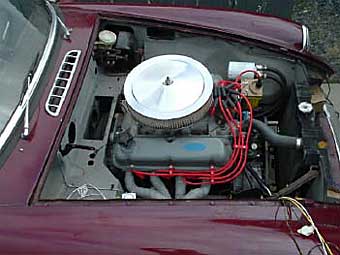 �
�
�
�
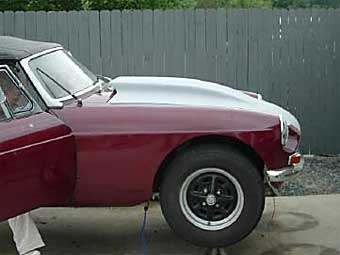 �
�
�
� by: Greg Myer�
� Since I told you the hard part of making the Ford fit in the early MGB, I'm going � to drop back and fill you in on the engine itself. As I noted, it's out of a pickup. � Larry wants reliability: a motor that always lights right up and idles smoothly. � It should sound good too. He wanted ease of operation too, just in case of an� emergency where his wife Cheri needed to drive it (she already foresees many of � these occasions arising). With the light weight of the B, any Ford V8 will create � a high performance atmosphere.�
�
�
�
 �
�
�
�
 �
�
Larry Nicholas' '64 MGB V8, part 2
� as published in British V8 Newsletter, Volume XII Issue 3, September 2004�� by: Greg Myer�
� Since I told you the hard part of making the Ford fit in the early MGB, I'm going � to drop back and fill you in on the engine itself. As I noted, it's out of a pickup. � Larry wants reliability: a motor that always lights right up and idles smoothly. � It should sound good too. He wanted ease of operation too, just in case of an� emergency where his wife Cheri needed to drive it (she already foresees many of � these occasions arising). With the light weight of the B, any Ford V8 will create � a high performance atmosphere.�
�
�
With all of this in mind, I sat down at the computer, armed with a Comp Cams catalog. �
Why the computer? Because I have the Dyno 200 Simulation program in it. There is a �
lot of information needed to get good results, but a little time is well spent here. �
Some of the information you need to enter is: manufacturer, engine type, bore size, �
stroke, valve size, ported or stock (street ported or race), V8 combustion chamber �
cc's and compression, CFM of the carburetor, intake manifold type, exhaust type-manifold �
or headers (large or small tube), open or muffled, and all the cam specs you can imagine, �
and some you can't (that's what the catalog is for). There's more if you want to get �
technical. How good is this program? I can't say for sure. As we all know, a pro �
engine builder can build 2 engines as identical as humanly possible, and have a 10, �
15, or 20 H.P. difference. So whatever the computer says isn't the final word. But... �
and it's a big but, by dialing in different specs on the basic setup, you can get a �
rather good idea of the H.P. or torque output of various cams, or carburetors, etc. �
It will also let you know where in the RPM range that power will be. That's important! �
With Larry's car we knew going in that we were going to use a Dana 44 with 3.07 gears, �
and a C-4 automatic, with a stock-like torque converter.�
�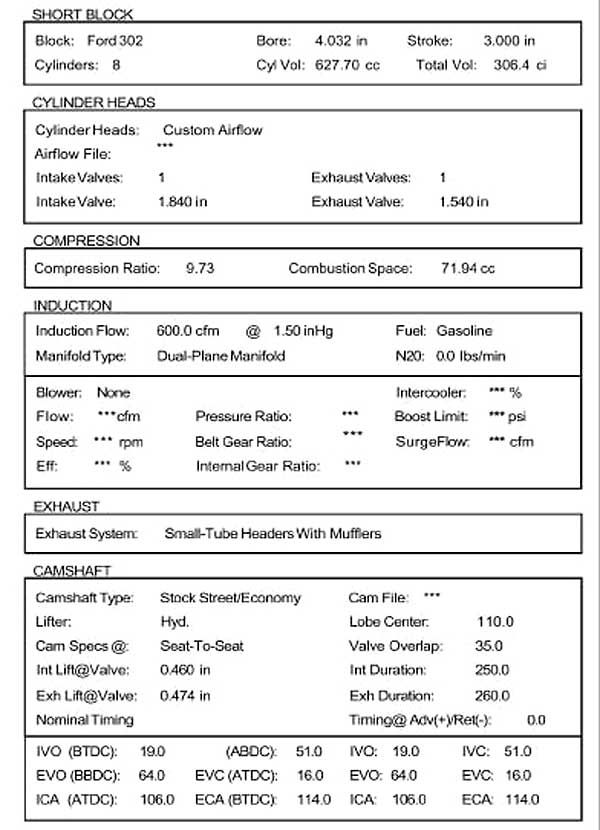
�
�
�
�

�
�
The engine will most likely never see the high side of 4500 RPM, and even that's wishful �
thinking. So, I typed in specs for several cams and came up with an XTREME ENERGY �
hydraulic cam which is a dual pattern design. Dual pattern meaning the intake and �
exhaust events are different. In this case, the exhaust valve opens farther and remains �
open for a long period of time, or degrees. That's important for the small block Ford. �
At least one with factory cast heads. The exhaust ports are more constricted than the �
intakes, making a tighter turn to exit.�
��
�
� What I wanted was a fat torque curve in the lower RPM's. This will work well on the � street with the higher gears and automatic. As the graph and charts show, the torque � is almost 350 at 2000 RPM and stays up there throughout the usable RPM range. �
� This will result in a good swift kick in the bucket seat when you punch the throttle. � This along with easy cruising and decent gas mileage should make a nice combination.�
��
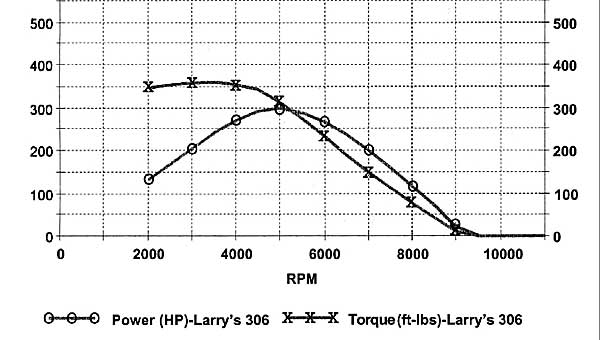 �
�
�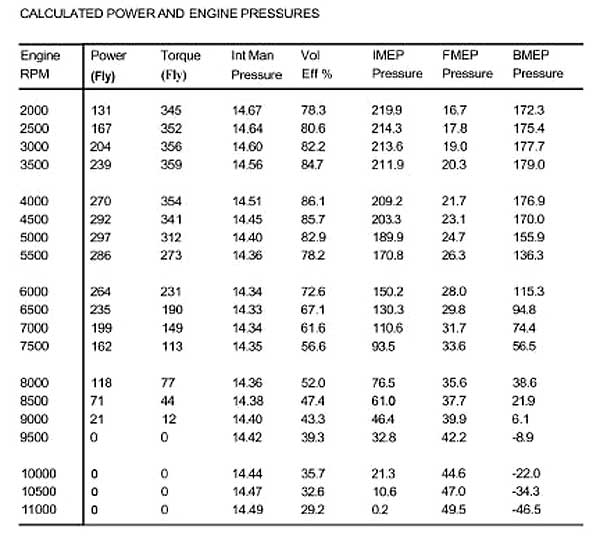 �
�
�
� I had an old Edelbrock F4B intake manifold. Larry liked that because it was the one � Shelby used on the Sunbeam Tiger when the engines were equipped with 4 barrel carburetors. � It's too high for the hood and a scoop had to be added, but more on that at a later � date. As built, the motor will be slightly different than the computer printouts. I � believe the compression will be slightly lower, and Larry got a deal on a Carter � carburetor from one of his buddies at work. It has a higher CFM rating than we used � here. Still, I think we have a reasonable view of what the results will be.�
�
�
�
�
| �
Enjoying this article? Our magazine is funded through the generous support of readers like you! � To contribute to our operating budget, please click here and follow the instructions. � (Suggested contribution is twenty bucks per year. Feel free to give more!)� |
� What I wanted was a fat torque curve in the lower RPM's. This will work well on the � street with the higher gears and automatic. As the graph and charts show, the torque � is almost 350 at 2000 RPM and stays up there throughout the usable RPM range. �
� This will result in a good swift kick in the bucket seat when you punch the throttle. � This along with easy cruising and decent gas mileage should make a nice combination.�
�
 �
�
�
 �
�
� I had an old Edelbrock F4B intake manifold. Larry liked that because it was the one � Shelby used on the Sunbeam Tiger when the engines were equipped with 4 barrel carburetors. � It's too high for the hood and a scoop had to be added, but more on that at a later � date. As built, the motor will be slightly different than the computer printouts. I � believe the compression will be slightly lower, and Larry got a deal on a Carter � carburetor from one of his buddies at work. It has a higher CFM rating than we used � here. Still, I think we have a reasonable view of what the results will be.�
�
�
A good way to check this is by going to the nearest drag strip. There you can have �
the car weighed and run it. Once it's dialed in, your MPH can be used in a math �
equation to determine exactly what HP is getting to the pavement.�
� I enjoy playing with... (ahem)... using this program in a scientific manner. (And it � sure beats playing solitaire or any other game in the computer.) Jeg's sells this � program for about $40.00 and I think it's money well invested.�
� Steve, a Triumph type friend, has a TR4. During a rebuild he brought me the head to � port, along with Triumph factory instructions. When I finished, I cc'd the chambers � and used all the information to feed this program. My HP and Torque graphs were close � to those supplied by the factory. Not exact, but very close. The engine is now in the � car and close to being fired up. Larry is itching for the running. He'll be here this � weekend to finish the wiring and we'll see what happens. �
� Disclaimer: This page was researched and written by Greg Myer. Views expressed � are those of the author, and are provided without warrantee or guarantee. Apply at your � own risk.�
�
�
� I enjoy playing with... (ahem)... using this program in a scientific manner. (And it � sure beats playing solitaire or any other game in the computer.) Jeg's sells this � program for about $40.00 and I think it's money well invested.�
� Steve, a Triumph type friend, has a TR4. During a rebuild he brought me the head to � port, along with Triumph factory instructions. When I finished, I cc'd the chambers � and used all the information to feed this program. My HP and Torque graphs were close � to those supplied by the factory. Not exact, but very close. The engine is now in the � car and close to being fired up. Larry is itching for the running. He'll be here this � weekend to finish the wiring and we'll see what happens. �
� Disclaimer: This page was researched and written by Greg Myer. Views expressed � are those of the author, and are provided without warrantee or guarantee. Apply at your � own risk.�

